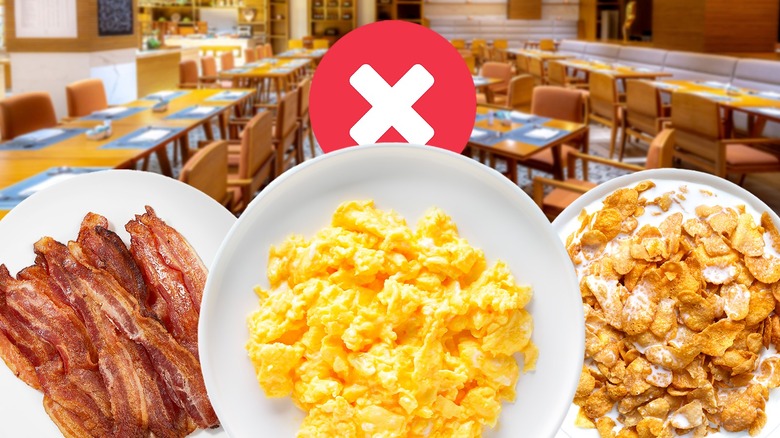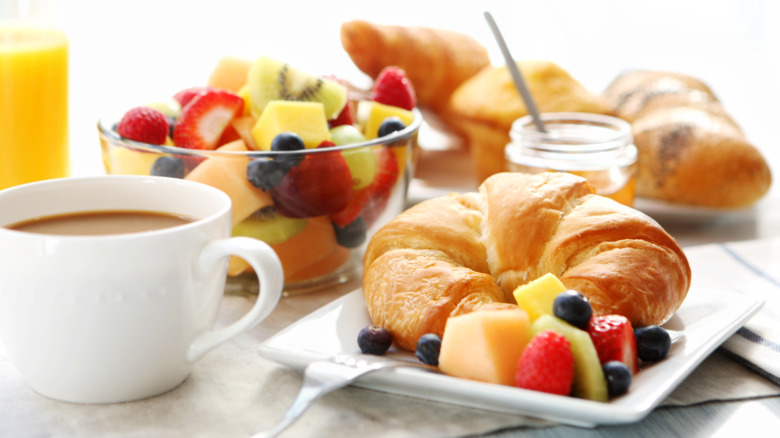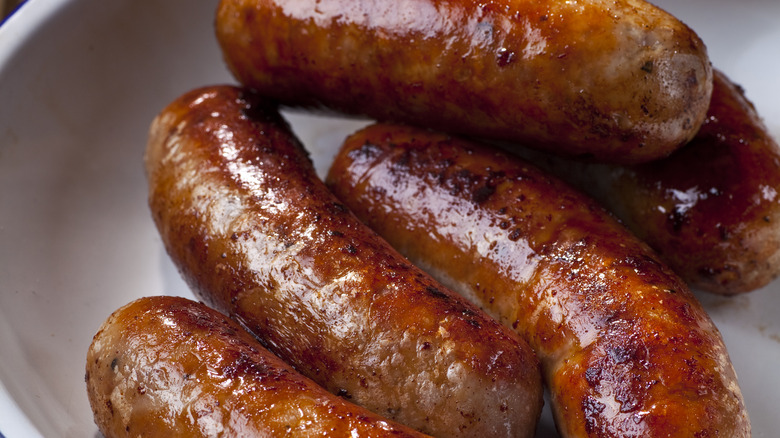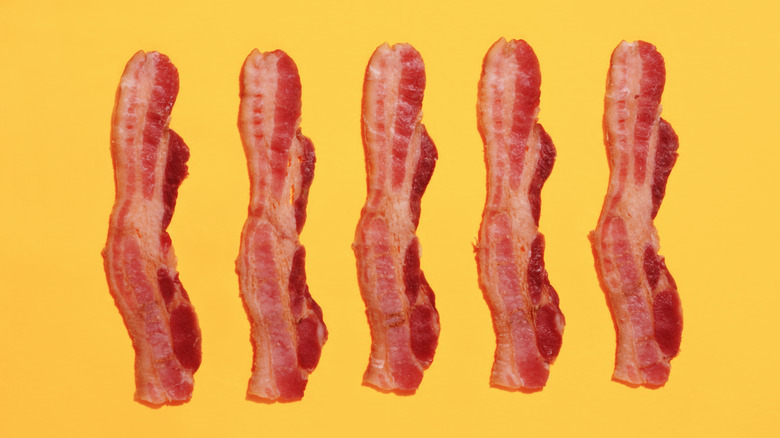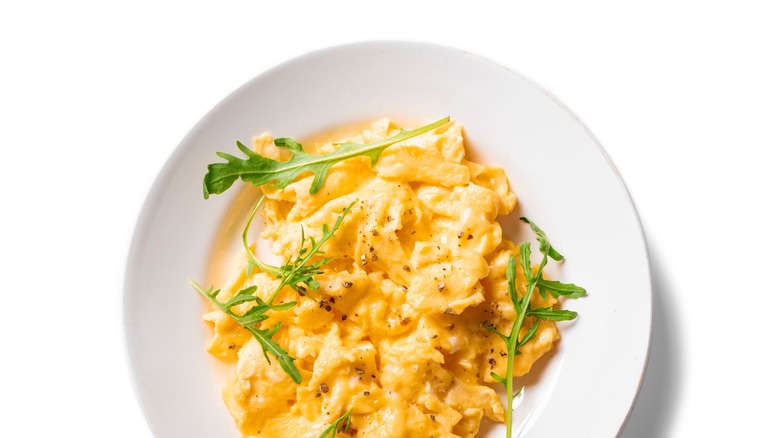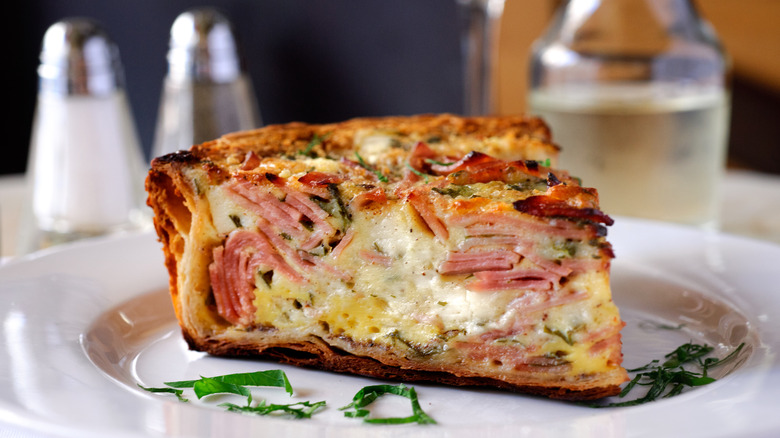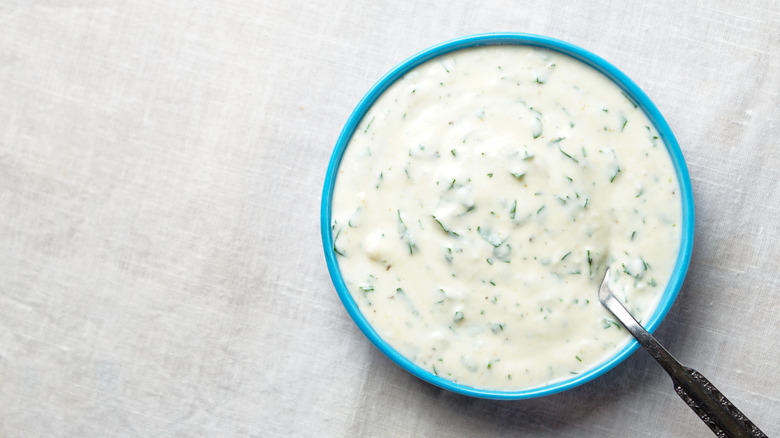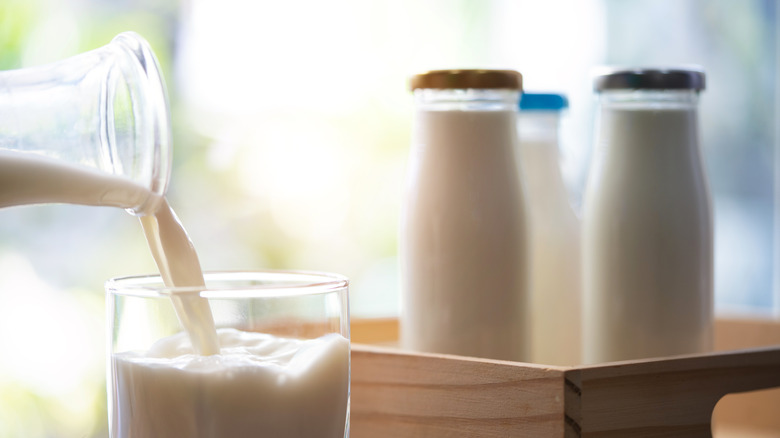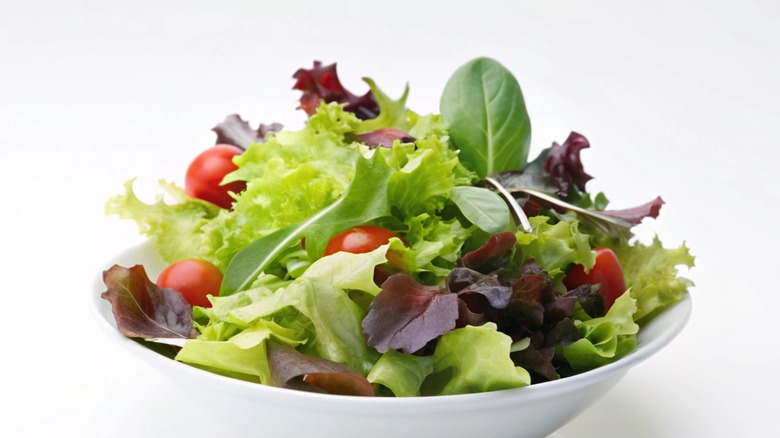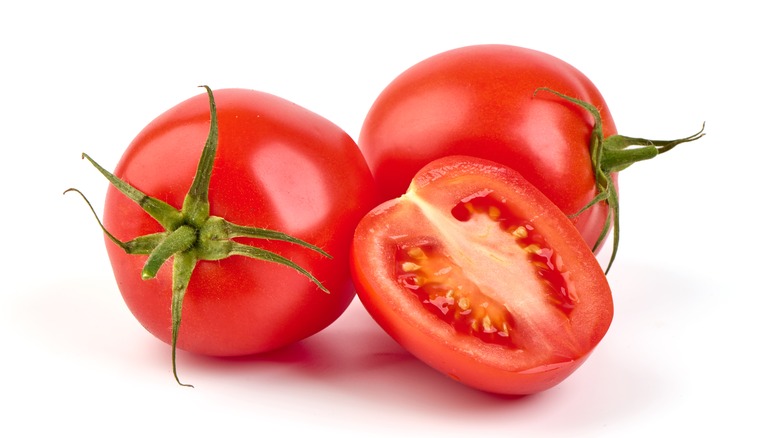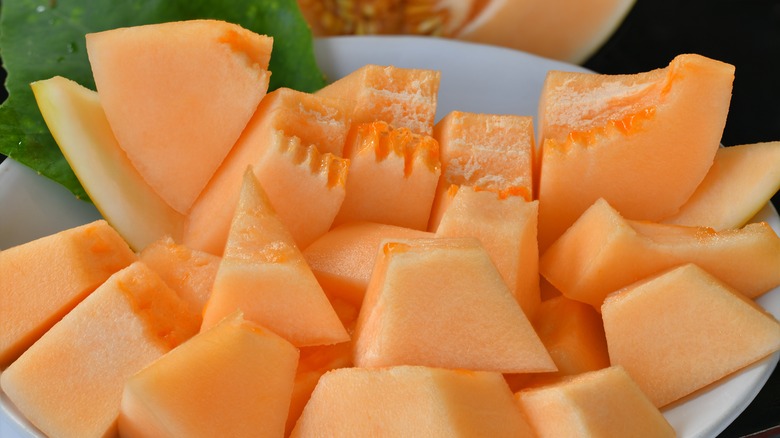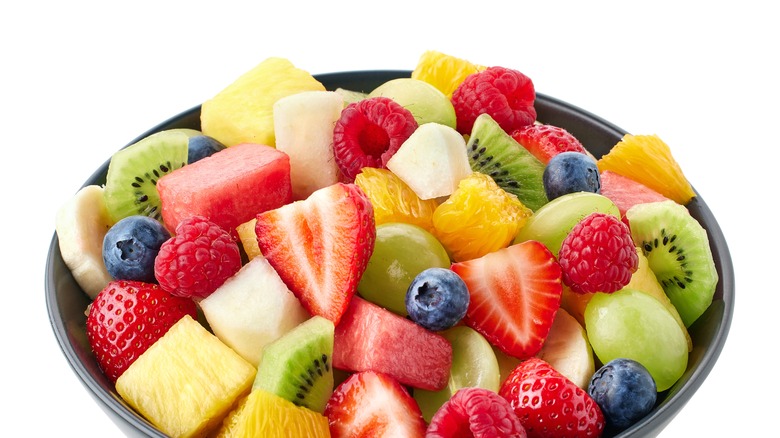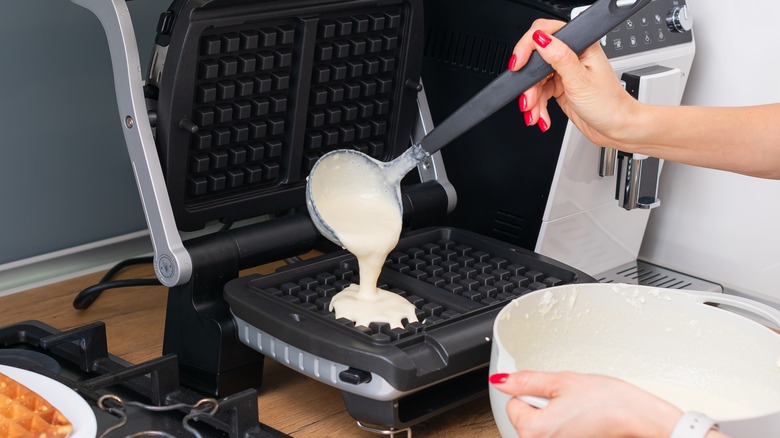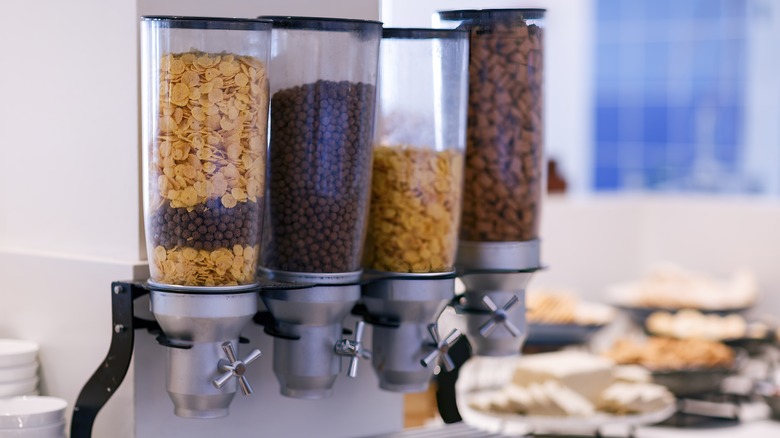Foods You Should Avoid At All Costs At The Continental Hotel Breakfast Buffet
"Continental breakfast included!" is often a selling point of hotel stays and packages. And sure, a nice continental breakfast has both convenience and budget on its side. Unfortunately, the dangers of communal food are real.
For instance, hepatitis A may be passed through communal food bowls by people who have it and didn't wash their hands thoroughly — and it's not the only communicable disease about which to worry. Speaking as someone who has managed to get food poisoning on continents across the world, this writer is here to say: Shady continental breakfasts are no joke.
That's not to say you can't enjoy a good morning buffet either at home or abroad, so no need to run screaming in the other direction just yet. The reality is, there are better and worse ways to go about it. Some foods are best bypassed at all costs, while others are fine if you approach them with caution. The main point is you should know what you're getting into. So, if you want to stay well and enjoy the best-quality options on offer, here's a handy guide to which foods to avoid and how to substitute for them instead.
What is a continental breakfast?
Before we dive into the dos and don'ts of sausage patties and everything else, let's take a second and ask: What exactly is a hotel continental breakfast? And what makes that breakfast continental as opposed to other free meals? And, most importantly, why were we not invited to the world's largest continental breakfast, thrown by Nutella in 2005? Held in Germany, it hit the Guinness Book of World Records for its 27,854 invitees, and frankly, there's some FOMO going on over here.
But back to the real question: What's a continental breakfast? The traditional definition is one that offers lighter fare: coffee and tea, juice, yogurt, fruit, bread products, and pastries with condiments. It earned this epithet in 1800s Britain, where the lighter fare represented by the European continent contrasted with the full English breakfast, the latter of which contains mountains of beans, toast, sausages, eggs, and tomatoes.
The intention of a continental breakfast is that it provide nourishment while withstanding several hours of low attention from hotel staff. However, with the idea of a continental breakfast becoming more popular and hotels introducing more fare, they often do feature cheese, meat, bacon, chorizo, and other traditionally heavier foods. Deluxe continental breakfasts often include meat and eggs. These, sadly, are foods more likely to be contaminated, but even traditional continental breakfast items are at risk.
Sausage or sausage patties
When someone gets food poisoning in a show or movie, it is nine times out of 10 a result of dubious meat choices. There's a reason for that: Undercooked, improperly handled, or incorrectly stored meat is one of the most common culprits for serious food poisoning. It can harbor everything from bacillus cereus to clostridium perfringens, E. coli to listeria, salmonella to staphylococcus aureus. Good. Times.
Sadly, sausage is not excluded from the sketch meat party. One of the main reasons it is so dangerous is that it is often kept at the wrong temperatures: neither cold enough nor hot enough to prevent the growth of bacteria. According to the United States Department of Agriculture, "Bacteria grow most rapidly in the range of temperatures between 40 F and 140 F, doubling in number in as little as 20 minutes."
Therefore, hot foods all come with a risk of food-borne illness when they are not kept at a consistent temperature above 140 F, which is far from a guarantee at a breakfast buffet. For that reason, you might want to bring your thermometer or skip the sausage.
Bacon
As with sausage, bacon is a danger because it is a rich bacterial growth medium. According to the awesomely named peer-reviewed journal Meat Science, "The main property which explains rapid microbial growth on meats is its composition: 75% water and many different metabolites such as amino acids, peptides, nucleotides, and sugars." In other words, everything our intestinal enemies love to get down with. That, combined with the risk of incorrect temperature maintenance, is a dangerous mix.
Although delicious at almost any temperature, bacon starts to breed bacteria as quickly as sausage, so you should probably avoid eating it unless you see it come hot out of the kitchen. Now, some people are safer than others when it comes to meat gambling. But children, the elderly, the immunocompromised, and pregnant people should all be especially careful when it comes to meat that is either undercooked, made into a spread, cured, or left at room temperature for too long.
Scrambled eggs
You probably won't even see scrambled eggs in many hotels, especially smaller ones where breakfast is served in the lobby, but larger ones often have a variety of egg options. And it makes sense that before a long day of sunning yourself at the beach or doing trust exercises with new coworkers, it's always nice to get some protein in. Nevertheless, you should think twice before eating scrambled eggs unless you see them arrive on the continental breakfast buffet line.
The danger arises from the fact that eggs should be served immediately after cooking. If they aren't, they're supposed to be refrigerated immediately, then reheated to 165 F before serving. Three guesses as to how often this happens at a continental breakfast buffet, the entire point of which is to eat when you're ready, without waiting for custom-ordered food.
As a final aside, lots of hotels use powdered eggs. It's up to you how you feel about this, but some sources say the macronutrient composition of powdered eggs is different from normal eggs.
Quiche
The same directions apply to quiche as do scrambled eggs: serve immediately or refrigerate and then reheat to 165 F. But except in the busiest of continental breakfast scenes, quiche is not consumed shortly after cooking; it sits around in dubious temperature environments for potentially long periods of time; and it is often made with low-quality ingredients. Also, industry recommendations for making quiche include the advice that older eggs be used, but busy hotel restaurants are unlikely to honor such specific recommendations.
Quiche is even riskier in hot environments. Whereas the traditional recommendation is to leave egg dishes out no longer than two hours at room temperature, the window drops to one hour if temps climb to 90 F or above. So that's a mega goodbye to quiche in hot states or countries. On a more culinary note, hotel quiches are often dry, boring, and crammed with old leftovers the restaurant wants to use up.
Condiments
Condiments might seem like an easy win, and we're all used to using them from the table at restaurants. It's true that some condiments are safer than others. According to research, mustard and pickle relish kill salmonella bacteria fairly quickly because they have low pH (high acidity), whereas ketchup didn't manage to kill its salmonella for a full day. Still, all three are naturally acidic and high in antimicrobial compounds.
Other condiments, though, are not so risk-free. It might surprise you to learn that peanut butter, for instance, is dicey. It can live in your cupboard, so why isn't it safe at the breakfast bar? Mainly because of its tendency to harbor bacteria when tainted, as has happened a number of times in manufacturing. It is difficult to decontaminate, so if it is transferred by human hands and shared utensils, that bacteria is likely there for good. Its shelf life might seem like a perk, but it's exactly because peanut butter can sit around so long without spoiling that food-borne bacterial illnesses can flourish.
You should also avoid open sauces or dips such as guacamole, since they often sit in the danger zone for long periods of time. Good condiments include individually packaged options, such as jams, iced cubes of butter, peanut butter packets, and small containers of Nutella. Honestly, any time you get a chance to eat Nutella, please do.
Room-temp milk or juice
As charmed as you may be by those old-fashioned milk bottles sitting on the buffet bar, you might want to watch out. Ditto adorable carafes of juice that make you think of lovely French hotels and Dutch balconies. Yes, they're cute and convenient, but that doesn't make them safe.
The opposite side of the danger zone from sausage and quiche, or any other hot food, is when foods are supposed to be cold but get stored above 40 F. This includes all cold beverages at the continental breakfast buffet. Milk must be stored at 40 F or below and cannot sit out for more than two hours outside this range. And remember, if the ambient temperature climbs above 90, you have to cut that down to one hour. Juice is slightly more forgiving at 41 F, but not much.
The thing is, while most milks and juices are kept cold at a buffet, they may not be kept cold enough. In fairness to any hotel, all these heat and cold requirements are a lot to monitor. Add to that the fact that hot and cold foods often sit near one another and a room full of human bodies makes it difficult to regulate temperature, and you've got a potential bacterial breeding ground. If you can't see when milk and juice come out and tell that they're nice and cold, or if they're not on ice, you might want to give them a miss.
Cut leafy greens
If you're scratching your head and thinking "Greens for breakfast?" then you're not alone. Yet in Israel, which this writer has been to several times to visit family, they unabashedly serve salad for the morning meal. Moreover, some types of breakfast sandwiches have greens on them, and small side salads are not uncommon for brunch.
Unfortunately, whenever possible, you should steer clear of the salad bar at a buffet. While they may look appealing, lettuce and other leafy veggies, once chopped, have a way of harboring some serious illnesses: norovirus, Shiga toxin-producing E. coli (STEC), campylobacter, and nontyphoidal salmonella. If you shivered just reading that list, you're not alone. While romaine lettuce is the worst culprit, all greens are suspect because they give bacteria time to thrive on moist surfaces that often aren't chilled to low enough temperatures to preserve food safety. If the greens aren't refrigerated or on ice, no dice.
Cut tomatoes
Again, tomatoes may not seem like the breakfast-iest of foods. However, they're a can't-miss item in the traditional English breakfast and its close cousin the Irish variant. You'll find them in salad-eating countries, as well. Finally, like lettuce, they often make an appearance in breakfast sandwiches. Unfortunately, also like lettuce, they can be a hotbed of salmonella if not properly chilled.
Although they are pretty acidic, the exposed flesh of cut or sliced tomatoes can still present a growing environment for this sometimes-deadly microbe, and the Food and Drug Administration has tracked a number of cases over the last several decades. As with juice, the safe temperature for cut tomatoes is 41 F or lower, so anything of the cut or sliced variety is probably best avoided unless it looks well-chilled. The best metric is to look and see whether the tomatoes are sitting on ice, which usually indicates they will be in the right temperature zone.
Melon
Because they're so sturdy when harvested underripe, melons are a common star in breakfast buffets. They look pretty and keep for a long period of time, so many hotels keep them on hand as a matter of course. Yet although it is a justifiable summertime favorite given its tender flesh and cool, sweet flavor, you should keep a weather eye on melon. Two, if you can spare them.
Melon is known to be risky and was recently investigated by the Centers for Disease Control for causing a salmonella outbreak. Spoiler alert: The melons were guilty. While it is rare that people get seriously harmed, salmonella is a dangerous disease that can cause hospitalization and even death, so it's worth paying attention.
Unfortunately, melon rinds are a great place for bacteria to lie in wait. E. coli, listeria, and salmonella are all common denizens of the rind. If the melon isn't washed properly, the pathogens can get transferred to the melon's flesh by the knife. Then, that same melon with those same bacteria gets left at unsafe temperatures in the danger zone, where it can quickly become unsound. Where possible, get your fruit fix from something with a peel or a rind.
Fruit salad
Not just sliced and diced but also dicey, fruit salad is a definite no-no for the breakfast buffet if you want to be sure to avoid food poisoning and enjoy your trip to the fullest. Not only do many (most?) fruit salads include the ubiquitously hardy melon, but they also have a bunch of other cut fruit. Unsafely stored or washed fruit, sadly, may harbor lots of bacteria that get transferred by knife onto the soft inner surfaces. Moreover, fruit sitting on a buffet line provides lots of exposed surface area to nurture diseases such as salmonella and listeria.
Granted, any fruit salad that looks fresh, bright, and glistening is likelier to be safe to eat than fruit that looks mushy, dull, or discolored, but you can't rely on the smell test as a means of measuring possible contamination. As with everything else on this list (and in life), sometimes it's a matter of judgment. At a 5-star hotel, you're likelier to get a good product than at a Best Western by the side of the highway. If you can, just skip the risk and opt for whole fruit in good condition or take fruit salad from bowls that are sitting on ice.
Waffle batter
Yes, waffle stations are fun. Yes, any excuse for whipped cream is a good excuse. No, continental breakfast waffle batter is not necessarily safe. Sorry to be the bearer of bad news, but industry insiders say that waffle batter isn't made fresh daily. Instead, hotel employees add new batter to sour old batter to extend its life, "until it starts to smell like beer," according to industry insider @brandaugustus on TikTok.
The problem? This can cause bacteria to grow. Since bacteria begin to die at about 150 F and waffle irons get as hot as 375 F, there is a good chance that at least some bacteria will get killed off during the cooking, at least on the outside of your waffle, but it's not a guarantee. Plus, the waffle maker often isn't even clean, and old food is another source of bacteria... not to mention pests. Maybe go out for brunch if you've got waffles on the brain?
Cereal
Unlike some of the other items on this list, cereal probably won't make you sick. It's dry and very shelf-stable, so it is unlikely to be a breeding ground for bacteria. It either comes out of a dispenser or is contained in single-serving packages, also protecting it (and you) from bacteria. So, if you're on vacation and feeling concerned about your options, cereal actually is the way to go.
However, few continental breakfast buffets offer healthy, low-sugar cereal options. Typically, you're looking at varieties such as Lucky Charms, Frosted Flakes, or Froot Loops. Even less-sugary-sounding brands contain pretty shocking amounts (especially considering we routinely give them to children). If cereal is all you've got and you're stuck for choices, go with something like shredded wheat or raisin bran, which is likelier to keep you full for a day or work or pleasure.
Ideally, though, you can skip the cereal altogether. Where possible, you should also avoid the other high-sugar options traditionally offered, such as wrapped pastries, high-calorie yogurt, and waffles. Look for hard-boiled eggs and plain yogurt for nutritious fare.
Bowls that require you to grab by hand
Now for some extra fun, let's circle back to the topic of hepatitis A! See, fun already. The truth is, hepatitis A is no laughing matter. While it usually clears up on its own after a few months, there is no treatment and it can be serious for the elderly and those with liver conditions. Even more unfortunately, it can be spread from unclean hands to prepared food, and such vectors account for 2% to 3% of cases.
Your new motto, therefore, is "No utensil? No deal." Bowls that have large mounds of items (pastry, rolls, and pieces of fruit, for instance) may seem safe, but they're not. People grabbing items by hand are likely to graze items they don't take, leaving you to deal with their unknown hygiene approach. And if you can't count on restaurant staff to wash their hands, you certainly can't count on the general public. Stick with tongs, period.
